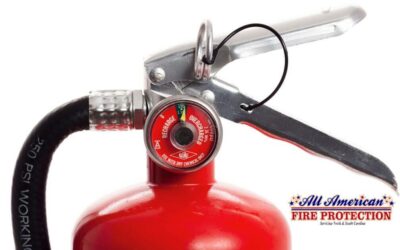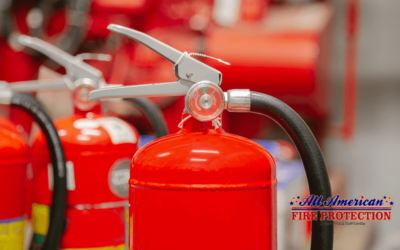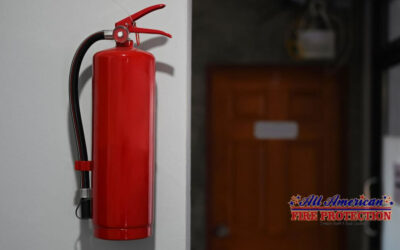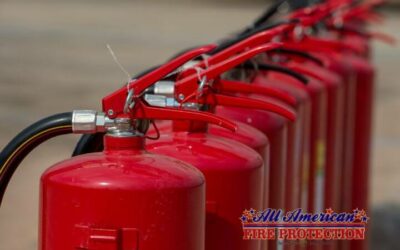Understanding Fire Extinguishers
Fire extinguishers serve as a crucial element in the safety strategy of your home or business, a sentiment echoed by All American Fire Protection, specialists in fire extinguishers. They offer a valuable initial defense against fires of small to medium scale, and their mere presence can enhance a sense of security. However, this sense of safety and effectiveness is only as good as your understanding of these reliable fire-fighting tools – their components and the various types available.
Fire extinguishers, like many technological devices, are composed of several parts that work in unison to fight fires. These key components include the handle or lever, the pin, a pressure gauge, the hose, and the cylinder that houses the extinguishing agent. A thorough understanding of how each of these parts functions can be a game-changer during a fire emergency.
Moreover, fire extinguishers are not a universal solution. They come in different types, each tailored to combat specific types of fires. Fires are categorized into Class A, B, C, D, and K, and there are extinguishers designed to match each class. Being aware of the potential fire hazards in your environment and the corresponding type of extinguisher can give you a significant advantage in controlling fires effectively.
While understanding fire extinguishers is key to their safe and efficient use, it’s important to remember that they are intended as a first line of defense for small, manageable fires. They are not a substitute for emergency services in the event of larger fire incidents.
Components of a Fire Extinguisher
A fire extinguisher is made up of several integral components, each playing a critical role in its operation:
- Handle/Lever: This is where you control the release of the fire suppressant. Knowing how to properly grip and operate the handle is crucial as it triggers the discharge of the extinguishing agent.
- Pin: The pin serves as a safety lock, preventing unintentional discharges. The fire extinguisher becomes operational only when the pin is removed, enabling the handle to be squeezed.
- Pressure gauge: This feature allows you to keep track of the extinguisher’s pressure. It indicates if the pressure is too high, too low, or within the optimal range (in the green zone). Regular checks of the pressure gauge are necessary to ensure the extinguisher is always ready for use.
- Hose: The hose directs the extinguishing agent towards the fire. Proper aiming is essential to effectively extinguish the fire from its base.
- Cylinder: The cylinder, or body of the extinguisher, holds the fire suppressant under pressure. It’s crucial to ensure the cylinder is free from dents, rust, or any damage that could hinder the release of the suppressant.
- Extinguishing Agent: The agent within the extinguisher varies based on the type of fire it’s designed to combat. This could be water, foam, dry chemical, wet chemical, or CO2.
Grasping these components, their functions, and their proper use is vital during the initial moments of a fire incident. For instance, consider a small kitchen fire. If you know that the pin must be removed to activate the extinguisher and that the hose should be aimed at the base of the fire, you can swiftly and effectively control the situation.
Types of Fire Extinguishers
Understanding the variety of fire extinguishers available is crucial for effective fire management. Each extinguisher is uniquely designed to combat specific types of fires. Here’s a rundown of the main categories:
- Water Extinguishers: Ideal for Class A fires, these extinguishers are effective against fires fueled by paper, wood, and textiles. The extinguishing mechanism involves cooling the fire to halt combustion.
- Foam Extinguishers: These are primarily used for Class A and B fires, which include flammable liquids. The foam not only cools the hot substances but also suffocates the fire by cutting off its oxygen supply.
- Dry Powder Extinguishers: Also known as ABC extinguishers, these are versatile tools effective against Class A, B, and C fires, including those involving electrical equipment. They function by disrupting the chemical reaction within the fire.
- CO2 Extinguishers: Perfect for Class B and electrical fires, these extinguishers replace the fire’s oxygen with CO2, effectively smothering it.
- Wet Chemical Extinguishers: These are specifically designed for Class F fires, which involve cooking fat or oil. They cool the flames and react with the oil to form a soapy substance that seals the surface and prevents re-ignition.
- Metal Fire Extinguishers: Falling under Class D, these are used for fires involving metals like sodium, magnesium, or titanium.
Familiarizing yourself with each extinguisher type and its function can equip you to respond effectively and safely during a fire incident. Always remember to use the appropriate extinguisher to maximize effectiveness and minimize damage.
Pre-using Checks
In a fire emergency, swift and smart action is key. This includes conducting essential pre-use checks before operating a fire extinguisher. These checks can be categorized into two steps: situation assessment, which involves determining whether it’s safe and appropriate for you to tackle the fire, and fire extinguisher inspection, which ensures the equipment is in proper working condition. These rapid yet vital checks can prevent a minor fire incident from escalating into a major catastrophe. By recognizing the significance of these pre-usage checks and executing them promptly, you’ll be better prepared to handle fire emergencies safely and effectively.
Situation Assessment
Before you even consider using a fire extinguisher, it’s crucial to evaluate the situation at hand. Your safety, as well as the safety of others, is of utmost importance, and a misstep could exacerbate the situation.
Assessing the Fire’s Size: Fire extinguishers are designed to tackle small, contained fires in their early stages. If the fire has grown large or is spreading rapidly, the most prudent action is to evacuate.
Determining the Fire’s Class: It’s essential to identify the fire’s class – whether it’s Class A, B, C, D, or F. Using an extinguisher that’s not suitable for the fire class can be ineffective and potentially hazardous.
Planning an Exit Strategy: Make sure the fire or smoke doesn’t obstruct your escape route. In case the fire intensifies, you need a safe exit path.
Evaluating Physical Capability: Operating a fire extinguisher requires a certain degree of physical strength and endurance. Ensure that you or another individual present can handle it.
Always remember, the initial response to a fire should be to alert others, activate the fire alarm system, and dial 911 or your local fire department. However, if the fire remains small and manageable, using a fire extinguisher could be the right choice, provided the above factors have been considered.
Fire Extinguisher Inspection
After evaluating the situation and determining it’s safe and appropriate to use a fire extinguisher, you must inspect the device itself.
Identifying the Extinguisher Type: Verify that the extinguisher you have is suitable for the fire class you’re dealing with. If you’re unsure, refer to the label on the extinguisher.
Looking for Damages: Inspect the extinguisher for visible signs of damage, such as dents, rust, or a broken handle. If any of these are present, do not use the extinguisher.
Inspecting the Pressure Gauge: If the extinguisher has a pressure gauge, the needle should be in the green zone. If it’s in the red, the extinguisher could be over-pressurized and potentially burst, or under-pressurized and not discharge effectively.
Checking the Hose or Nozzle: Make sure the extinguisher’s delivery system isn’t blocked or damaged.
Verifying the Inspection/Expiration Date: Fire extinguishers have a finite lifespan and won’t work beyond the indicated inspection or expiration date.
By conducting these checks, you can ensure that the fire extinguisher is safe and ready for use. Only proceed if the situation is safe and the extinguisher is in proper working condition.
P.A.S.S. Method for Fire Extinguisher Usage
Successfully managing a fire hinges on the correct operation of a fire extinguisher. The universally accepted technique for this is the P.A.S.S. method, a four-step process that ensures maximum effectiveness even in the high-stress situation of a fire. This acronym stands for Pull, Aim, Squeeze, and Sweep. Each step is crucial and will be dissected in detail to provide a comprehensive understanding of the process. Let’s dive into the first step.
Pull the Pin
Initiating the P.A.S.S. method begins with Pull the Pin. This pin is a safeguard designed to prevent unintentional discharge of the fire extinguisher. You’ll find it at the top of the device. To disengage the pin, grasp the extinguisher with the nozzle directed away from you and firmly pull the pin from its position.
This action breaks the tamper seal, priming the fire extinguisher for use. It’s important to maintain the extinguisher in an upright position, with the base on the ground, during this process to avoid accidental discharge or potential injury.
It’s crucial to note that pulling the pin doesn’t trigger the extinguisher; it merely readies it for the subsequent steps. Always ensure the extinguisher is never aimed at yourself or others, as the pressurized contents can cause injury if inadvertently released.
Aim the Hose
The second phase of the P.A.S.S. technique is Aim the Hose.
After preparing the extinguisher for use, direct the nozzle or hose towards the fire’s base, not the flames. This is a critical distinction as the fire’s fuel source is at the base, not in the flames.
Maintain a safe distance, generally between 6 to 8 feet. If it’s necessary to get closer, be cautious of the potential hazards such as inhaling smoke or steam, or suffering burns.
By aiming accurately, you can blanket the fire’s base with the extinguishing agent, effectively suffocating it. The goal here is to ensure every discharge is effective, making the precision of your aim crucial.
As a safety measure, always keep an exit within your field of vision when operating the fire extinguisher.
Squeeze the Handle
With the nozzle accurately aimed, the next step in the P.A.S.S. technique is to Squeeze the Handle.
This action releases the extinguishing agent onto the fire. Grasp the extinguisher firmly with both hands and apply a slow, even pressure on the lever to begin discharging the agent. Be aware that a hard or abrupt squeeze could cause the extinguisher to jerk in your hands.
Misjudging this step could lead to a premature depletion of the extinguishing agent or insufficient coverage of the fire. The objective is to maintain a steady, controlled discharge that effectively smothers the fire at its base.
Remember, fire extinguishers have a limited discharge time, usually between 10 to 20 seconds. Make every second count and maintain control of the extinguisher throughout its operation.
Sweep the Nozzle
The final stage of the P.A.S.S. technique is Sweep the Nozzle.
After aiming and squeezing, it’s time to sweep. Direct the hose from one side to the other at the base of the fire, discharging the extinguisher’s contents. The goal is to smother the fire at its source.
Ensure you cover the entire area of the fire systematically. Begin from the side closest to you, then progress towards the farthest edge, all the while maintaining a sweeping motion. This strategy helps prevent the fire from spreading and suffocates any ignited materials.
While performing this action, it’s crucial to keep an eye on the fire’s behavior. If the fire doesn’t seem to be diminishing or if it begins to escalate, it’s time to leave the area immediately and contact your local fire department.
This concludes the P.A.S.S. technique for using a fire extinguisher. Remember, your safety is paramount. If at any point the situation becomes too dangerous or the fire becomes unmanageable, evacuate immediately and call for professional assistance.
Post-use Actions
Once you’ve used a fire extinguisher, there are several important steps to follow to ensure your safety and readiness for any future fire emergencies. These include evacuation procedures, reaching out to emergency services, and taking care of the fire extinguisher by recharging or replacing it. Adhering to these steps not only safeguards your immediate safety but also prepares you for any potential fire emergencies in the future.
Evacuation and Emergency Services
In the event that a fire persists after the use of a fire extinguisher, your next course of action should be to evacuate immediately. Even if the flames appear to be under control, lingering smoke and fumes can still present a significant risk. Proceed to a predetermined safe location, ensuring all individuals are present and accounted for.
Promptly alert emergency services at the first sign of a fire, regardless of its perceived size or severity. This allows professionals to evaluate the situation and confirm that the fire has been completely extinguished.
Refrain from reentering the building until the fire department has given explicit permission to do so. Hidden hot spots can cause a fire to reignite, making it essential to wait for professional approval.
The primary focus in any fire situation should always be the preservation of human life. While fire extinguishers serve as an important initial response tool, they are not intended to replace the expertise of professional firefighting services.
Fire Extinguisher Recharging or Replacement
Following its deployment, a fire extinguisher must be either recharged or replaced to ensure it remains an effective safety measure.
Rechargeable fire extinguishers require a new supply of extinguishing agent after use. A certified professional typically oversees this process, which includes inspecting the extinguisher for any physical damage, depressurizing it, refilling it, re-pressurizing it, and resealing it.
Disposable fire extinguishers, on the other hand, should be safely discarded and replaced with a new unit after even partial use.
Maintaining a stock of operational fire extinguishers is a key component of any comprehensive fire safety plan. Regularly inspect your extinguishers to ensure they are in working order and ready for use in the event of an emergency.
Maintenance of Fire Extinguishers
The upkeep of your fire extinguishers is as vital as understanding their operation. Regular maintenance is a proactive measure that not only guarantees the extinguisher’s functionality during emergencies but also prolongs its service life. This process includes routine visual inspections and professional evaluations, both of which are instrumental in detecting and addressing any potential issues that could hinder the extinguisher’s performance in a crisis.
Monthly Visual Checks
The foundation of fire extinguisher maintenance is the execution of monthly visual inspections. This straightforward procedure can be performed by anyone, eliminating the need for professional intervention.
During this inspection, confirm that the extinguisher is properly positioned, easily accessible, and primed for use. Examine the device for any physical impairments such as dents, leaks, or corrosion.
The pressure gauge should also be within the functional range, typically denoted by a green zone. A gauge reading below this range suggests that the extinguisher might not discharge as expected, while a reading above this range could imply an overfilled unit, which is equally hazardous.
Assess the pull pin and tamper seal. A broken seal or absent pin indicates that the extinguisher might have been previously used and could require a recharge or replacement.
Lastly, check for any maintenance or servicing tags on the extinguisher. An expired or missing inspection tag signifies that the extinguisher is due for a professional evaluation.
Bear in mind, these regular visual inspections are crucial in spotting minor issues before they escalate into significant problems.
Annual Professional Inspection
Beyond the scope of monthly visual checks, there’s a crucial need for a comprehensive, professional inspection of your fire extinguishers on an annual basis. This is not just a recommendation, but often a legal requirement. This rigorous examination should be performed by a certified professional, well-versed in the nuances of fire extinguisher maintenance.
The professional inspection delves deeper into the health of your fire extinguisher. It scrutinizes the internal pressure and the condition of various components more thoroughly than a routine check. The professional will evaluate the overall state of the extinguisher, ensuring it aligns with all safety regulations, and will advise if servicing or replacement is warranted.
To illustrate, the inspection process may involve disassembling the extinguisher to inspect for internal corrosion, replenishing any diminished pressure, and resealing the extinguisher for future use.
After the inspection, the professional will attach a new service tag to the extinguisher. This tag, bearing the date of the most recent inspection, serves as a clear record of the extinguisher’s service history for all users.
In conclusion, annual professional inspections are a key factor in maintaining your readiness for fire emergencies. They enhance the reliability of your fire extinguishers, potentially playing a vital role in safeguarding lives and property.







